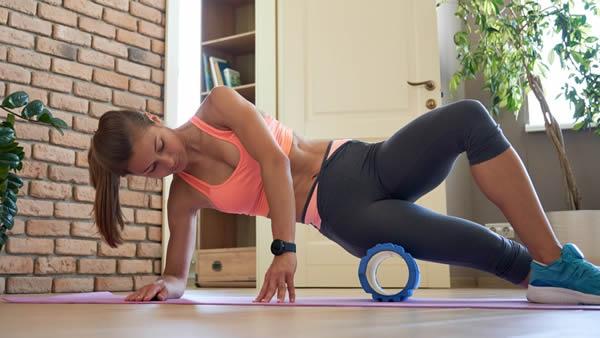
Heather Jeffcoat, DPT
Foam Roller Exercises to Improve Mobility
Reduce inflammation and improve flexibility with these 8 exercises for women.
If you’ve never invested in a foam roller — commonly found at sporting goods stores for 20 to 40 bucks — you’re doing your muscles a major disservice. Regularly using a foam roller offers many of the same benefits as a sports massage, including reduced inflammation, scar tissue and joint stress, as well as improved circulation and improved flexibility.
Foam rolling helps with increasing muscle flexibility and joint range of motion, especially when used in conjunction with an active warm-up routine,”
says Heather Jeffcoat, DPT, certified facial stretch therapist and owner of Los Angeles–based Fusion Wellness & Physical Therapy.
It also helps with muscle-force production when done before exercise, reducing exercise-induced muscle soreness, reducing delayed onset muscle soreness, increasing pressure pain threshold and reducing trigger-point sensitivity.”
Timing and Tips
The timing of using this self-massage tool also matters. Jeffcoat suggests foam-rolling the desired muscle groups immediately before a workout to increase flexibility of the muscle and range of motion of the nearby joints.
Pre-activity, foam rolling has been shown to reduce muscle stiffness and improve range of motion,” Jeffcoat says. “The best results are seen when it’s used with dynamic stretching and an active warm-up. Research supports using the foam roller over the desired area for 90 seconds up to two minutes — longer has shown negative results in performance.”
She also suggests using it immediately postworkout to reduce DOMS and exercise-induced muscle damage.
The following exercises can be performed separately or combined into a 10-minute preworkout or postworkout routine. Since it’s best to perform roller exercises once your muscles are warm, you’ll need to do a quick five-minute warm-up if you opt to do them right before a weight-training session.
For each exercise, slowly roll back and forth as described for 20 to 30 seconds before moving on to the next exercise. As you roll, take deep, slow breaths to help your muscles relax. Always avoid rolling onto your joints — the roller should stay positioned under your muscles at all times — and if you hit a particularly tight or tender spot, stop rolling and apply direct pressure for 30 seconds, or until the pain abates.
For recovery, the research supports using as much pressure as possible while respecting your boundaries for pain,” Jeffcoat suggests. “And use caution when using a foam roller for inter-set activities. If you are rolling your quadriceps exclusively, research shows a decrease in hamstring activation. This could lead to a decrease in performance, specifically in a person’s ability to continually produce force of the hamstrings. This occurs due to a phenomenon called reciprocal inhibition, where activation of one muscle group creates an inactivation in the opposing muscle group.”
If you’re new to foam rolling, only incorporate this series of moves into your routine every other day for two to three weeks. After that, you can try doing it once or twice daily — both before and immediately after your workouts.
For the final word on foam roller exercises to improve mobility, use this link to continue to the full article at Oxygen.com.
